Description
The coconut palm, Cocos nucifera, is an erect palm in the family Arecaceae which is grown its fruits, used primarily for the extraction of coconut oil for use in cooking. The coconut palm has an erect or slightly curved stem which grows from a swollen base. The stem is smooth, light gray in color and has prominent leaf scars. The stem is topped with a crown of 60–70 spirally arranged leaves. The leaves are long (up to 7 m/23 ft), pinnately divided and composed of 200–250 tapering leaflets. The inflorescence is a spike produced at the leaf axil with 20–60 branches, each with a female flower at the base and many male flowers. The fruit is a drupe containing a single seed. It is ovoid in shape with three sides divided by ridges. The exocarp and the mesocarp make up the husk of the coconut. The seed is protected by a thick, stony shell, or endocarp, and is partially filled with a liquid known as coconut water. The edible endosperm is white and meaty and can be between 1.0 and 2.5 cm (0.4–1.0 in) thick. Coconut palms can reach a height of 30 m (98 ft), produce up to 75 fruits a year, and live for up to 90 years. The origin of the coconut is unknown although the center of genetic diversity lies in Southeast Asia.
Crop Details
Scientific Name: Cocos nucifera
Common Name: Mnazi (Swahili)

Coconut propagation

Harvested coconut drupes

Coconut seed cut open to reveal flesh

Coconut inflorescence

Coconut drupes

Coconut seedling

Close-up image of coconut palm leaf

Coconut palms can reach 30 m (98 ft)

Coconut palms with coconuts
Uses & Benefits
Coconuts are primarily cultivated for their oil. The oil is extracted from the endosperm and is used in cooking. Low grade oils are used in the production of soaps. The endosperm can be consumed fresh or dry and is commonly grated for use in baking. Young coconuts, termed waternuts, are commonly sold in tropical resorts, where the liquid is drunk directly from the shell. Coconuts may also be used to produce coconut milk by squeezing the liquid from the grated endosperm. Coconut milk is popularly used in many dishes from Southeast Asia.
Varieties
West Coast Tall Coconut: This tall coconut tree bears fruit in 6-7 years and produces around 60-80 coconuts per palm, each year. It is drought-tolerant, and the color of the fruits varies from green to yellow and orange to brown.
The East Coast Tall coconut: East coast tall produces around 60-70 coconuts on each palm every year and takes 6-8 years to yield fruits. This tall coconut tree needs well-drained, loamy soil to thrive.
Maypan Coconut: Hybrid of Malayan and Panama; Maypan is a cold-hardy variety, producing medium to large-sized coconuts. Growing up to 20-meters, this variety is also resistant to lethal yellowing disease.
Tiptur Tall Coconut: Leathery fronds of tiptur tree produce 6-12 inches long fruits. It starts bearing fruits in 6-7 years from the planting and produces 70-80 coconuts on each palm, every year. It is one of the best coconut tree variety to grow.
Orange Dwarf Coconut: Producing fruits in 3-4 years, this dwarf variety can yield around 50-70 drupes per palm each year. Each crown of this tree consists of 20-28 leaves. Avoid growing this palm tree in the wind prone areas, as it may get damaged due to strong winds.
Green Dwarf Coconut: This palm tree yields around 60-70 coconuts per palm and begins fruiting in 3-4 years. Its drupes are dark green and resistant to root wilt disease.
Malayan Yellow Dwarf Coconut: This palm has a yield of 50-60 coconuts on each palm per year and starts bearing fruits after 3-4 years. It is native to Indonesia and is resistant to lethal yellowing disease.
Fiji Dwarf Coconut: This tropical ornamental tree is popular for its long fronds and a swollen trunk base. Its unique leaf arrangement makes it different from others and has a large bulb at its lower stem. Thanks to its durable nature, it has earned the name- Tough nut.
Other coconut varieties include, VHCI coconut, Macapuno coconut and King coconut.
Propagation
Basic Requirements
The coconut palm is a tropical plant and is generally grown in humid, tropical regions. It grows optimally in areas with an annual mean temperature of 27°C (80.6°F) with in excess of 2000 hours of sunlight per year. The palm will thrive in a wide range of soils from sand to clay as long as they are well draining and well aerated with a pH between 4.3 and 8.0. Although palms are often found growing on sandy beaches, they can be successfully grown inland but will not tolerate freezing temperatures.
Growing from Seed
Coconut palms are propagated exclusively from seed. The seeds are ready for planting when the coconut milk can be heard sloshing around inside the seed when it is shaken. Seeds are germinated by planting in seed beds before transferring to a polythene bag or nursery beds after germination. Seeds should be planted on their sides in a shallow hole with enough soil to cover about one third of the seed. The seed should be watered regularly to prevent it drying out. Germination usually occurs after about 3 months but may take up to 6 months.
Coconut seedling can be transplanted from 6 months onwards or transferred to pots and grown further in the nursery. Trees require a wide spacing and are typically planted 8–9 m (26–30 ft) apart allowing a further 8–9 m (26–30 ft) between rows. Dwarf varieties can be spaced closer together and are typically planted 7.5 m (25 ft) apart allowing another 7.5 m (25 ft) between rows
General Care and Maintenance
The nuts ripen during the entire year. As a rule, a harvest is carried out every 1-2 months, when the ripened coconuts are harvested directly from the tree - farmers should not wait until the nuts fall from the tree. The nuts are fully ripened when the coconut water can be clearly heard sloshing against the inside when they are shaken. Harvesting too early can unfavorably affect the quality of the copra.
Harvesting
Stock plants that are suitable seed providers produce 100 nuts per year and up to 180 g copra per nut. In drier areas yields are usually 15-20 nuts/tree/year. Harvest fully-ripened nuts intended to provide seeds after 11-12 months. Cut down nuts and lower them carefully (e.g.by rope). Do not allow the nuts to fall down. Following the harvest, store nuts for a short break in a covered, well- ventilated place.
Drying
Sun drying
Remove the husk first. Dry nuts on a clean surface to reduce moisture from 45% to 6%. In fine weather this takes about 5 days. Turn the pieces occasionally and cover them at night and in rainy weather.
Kiln drying
Make a fire in the pit of the kiln. Use the coconut shells as fuel as they heat well and smoke little. Put the copra on a wire mesh platform over the fire and protect it from the rain. This takes about 4 days.
References
Broschat, T. K. & Crane, J. H. (2011). The Coconut Palm in Florida. University of Florida IFAS Extension. Available at: http://edis.ifas.ufl.edu/pdffiles/MG/MG04300.pdf. [Accessed 13 November 14].
Free to access.
CABI Crop Protection Compendium. (2014). Cocos nucifera datasheet. Available at: http://www.cabi.org/cpc/datasheet/11788. [Accessed 13 November 14].
Paid subscription required.
Chan, E. & Elevitch, C. R. (2006).
Cocos nucifera (coconut). Species profiles for Pacific Agroforestry. Traditional Tree Initiative. Available at: http://www.agroforestry.net/images/pdfs/Cocos-coconut.pdf. [Accessed 13 November 14].
Paid subscription required.
Duke, J. A. (1983).
Cocos nucifera L.. Handbook of Energy Crops. Available at http://www.hort.purdue.edu/newcrop/duke_energy/Cocos_nucifera.html#Cultivation. [Accessed 13 November 14].
Free to access.
Elliott, M. L., Broschat, T. K., Uchida, J. Y. & Simone, G. W. (2004). Compendium of Ornamental Palm Disease and Disorders. American Phytopathological Society Press. Available at: http://www.apsnet.org/apsstore/shopapspress/Pages/43143.aspx.
Available for purchase from APS Press.
Common Pests and Diseases
Diseases
Category : Fungal
Bud rot and nutfall
Phytophthora spp.
Fusarium solani
Fusarium moniliforme
Graphium spp.

Coconut tree infected with bud rot pathogen Phytophthora palmivora
Symptoms
Chlorosis of youngest open leaves; leaves rapidly turning necrotic; necrotic spots on leaf bases; unopened spear leaves can be pulled away from the plant easily; removal of unopened spear leaves reveals soft, pink-red tissue with foul smell; leaf necrosis spreading through central crown leaves; woody parts of plant may have water-soaked, pink lesions with dark borders; infected inflorescences abort nuts.
Cause
Oomycete
Comments
Management
Control of the disease is reliant on good sanitation practices and the use of appropriate systemic fungicides; remove all infected debris and dead trees from plantation and destroy; irrigate trees early in the day to allow surfaces to dry off during the day.
Ganoderma butt rot
Ganoderma spp.
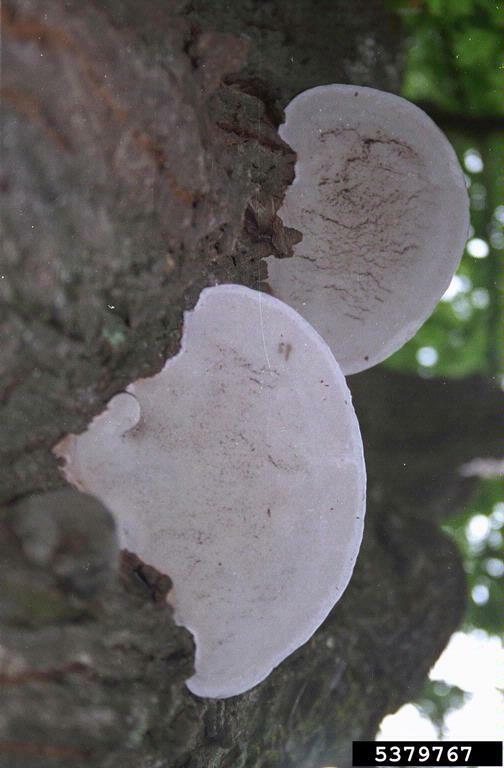
Fruiting bodies

Close-up of Ganoderma root and butt rot fruiting bodies

Ganoderma root and butt rot (Ganoderma australe) fruiting bodies
Symptoms
Older fronds turning yellow and gradually wilting and drooping; fronds collapsing and dying; internal tissue of lower stem discolored; overall reduction in vigor.
Cause
Fungi
Comments
Management
Spacing trees widely limits the chance of infection through root grafts; avoid damaging tree trunks with tools and machinery; remove any dead or severely damaged trees from plantation immediately, including any that have been killed by natural processes; if a site is known to be infected with the disease, the ground should be fallowed for at least 1 year prior to a new plantation being established.
Gray leaf blight
Pestalotiopsis palmarum

Symptom

Pestalotiopsis leaf spot (Pestalotiopsis palm arum) sign
Symptoms
Small, yellow-brown spots on leaflets which develop gray centers and dark green borders; lesions coalesce to form large necrotic patches; tips of leaflets turning gray; canopy has blighted appearance.
Cause
Fungus
Comments
Management
Disease usually only merits control in coconut nurseries as infection of mature coconut palms are rare; appropriate broad spectrum protective fungicides should be applied.
Lethal bole rot
Marasmiellus cocophilus
Symptoms
Oldest leaves of palm turning yellow and wilting; reddish-brown rot in bole tissue; destruction of root system
Cause
Fungus
Comments
Management
Any infected trees must be uprooted and burned; area can only be replanted once soil is treated for the disease
Stem bleeding disease
Chalara paradoxa (syn. Thielaviopsis paradoxa, Ceratocystis paradoxa)
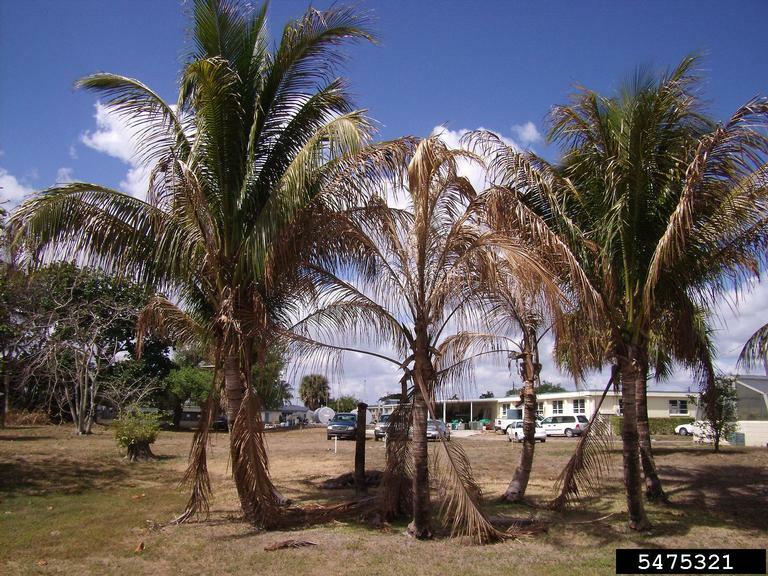
The canopy of the coconut in the center is wilted and necrotic due to a trunk infection by Thielaviopsis paradoxa.

Only one side of this trunk has significant rot due to Thielaviopsis paradoxa. The fungus rots the trunk tissue from the outside to the inside.
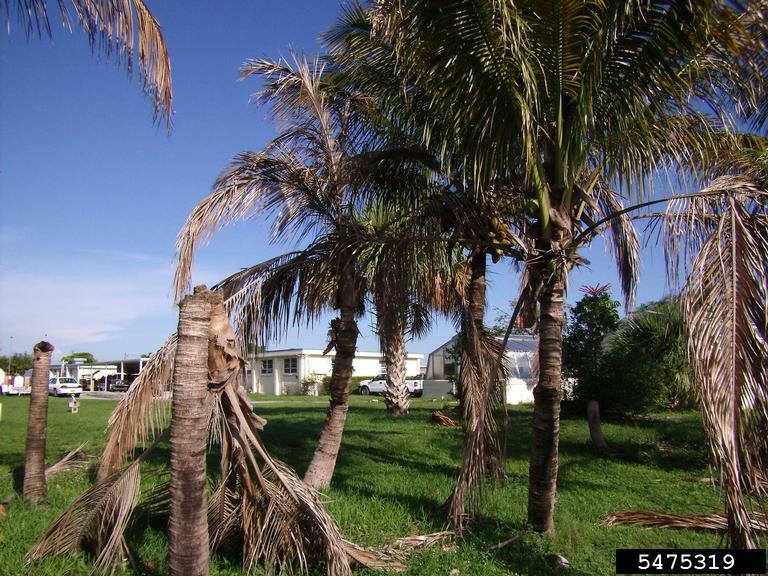
The three coconuts on the left have died from Thielaviopsis trunk rot. The palm in the foreground exhibits trunk collapse.

The trunk of this coconut was just beginning to exhibit "stem bleeding", but the large rusty-brown area at the top was already soft.

Trunk collapse due to stem bleeding disease

Stem bleeding on a coconut trunk. The top of the blackened area was very soft and could be easily pushed in with the fingers.
Symptoms
Soft, yellow rot on trunk; affected areas are dark and turn black as they mature; a reddish-brown liquid may ooze from rotting regions and spill down trunk.
Cause
Fungus
Comments
Management
Avoid wounding palms with machinery and tools to reduce disease incidence; disease can be controlled with applications of the fungicide benomyl where registered; infected trees should be removed and destroyed as soon as possible.
Category : Viral
Cadang-cadang
Coconut cadang-cadang viroid (CCCVd)

Area with cadang-cadang disease showing trees in the early, medium and late stages of the disease.
Symptoms
Newly formed nuts more rounded than in previous years; nuts exhibit scarring on the surface; chlorotic spots on leaves; stunted inflorescences with tip necrosis; leaves begin to decline in size and number; death of palm.
Cause
Viroid
Comments
Management
There is currently no known method of controlling the disease.
Coconut foliar decay
Coconut foliar decay virus (CFDV)
Symptoms
Some varieties which have the disease may show no symptoms, others exhibit partial yellowing of leaves which begins to spread to leaf tip; necrosis of petioles causing leaves to die and hang from palm canopy
Cause
Virus
Comments
Category : Other
Lethal yellowing (Palm lethal yellowing)
Candidatus Phytoplasma palmae (PLY)

Infected trees

Damage due to lethal yellowing

Lethal yellowing infected coconut trees

Infected coconut trees

Lethal yellowing infected palm
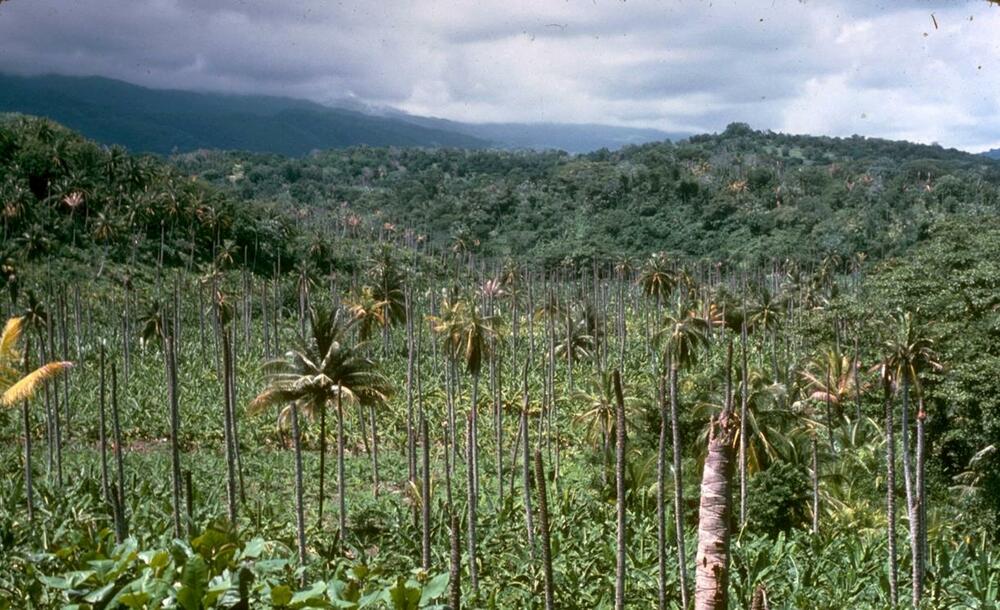
Symptoms of lethal yellowing on coconut palm

Lethal yellowing damaged tree

Cocos nucifera spear leaf is dying just as the last leaves are discoloring due to lethal yellow phtyoplasma
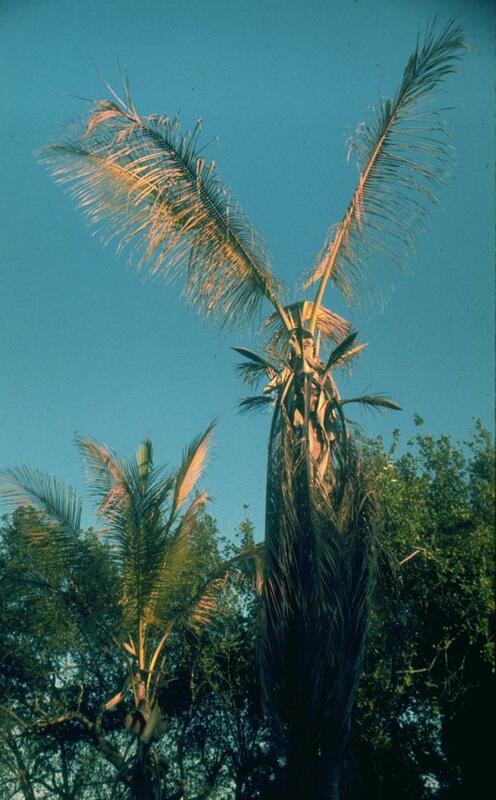
Symptoms of lethal yellowing on coconut palm
Symptoms
Premature dropping of fruit; fruit with brown-black water-soaked appearance; necrosis of inflorescences; flower stalks turn black; lower, older leaves turning yellow; entire crown turning yellow; yellow leaves turn brown, dry out and hang from canopy.
Cause
Phytoplasma
Comments
Management
The most effective method of managing the disease is to plant resistant coconut varieties such as Malayan dwarf or Maypan; antibiotic treatment is effective but not usually practical for large scale plantings.
Pests
Category : Insects
Coconut bug
Pseudotheraptus wayi
Symptoms
Damged and/or aborted flowersd; sunken necrotic lesions and scars on nuts; young nuts may exude gum (gummosis) and die; many nuts fall from tree; adult insect is a brown-red with well-developed wings; nymphs are brown-red or green in color with long antennae and feed at the calyx of the nut
Cause
Insect
Comments
Management
Natural enemies of the coconut bug include weaver ants, conserve bushes and trees around plantation which are habitats for weaver ants or intercrop with mango, guava or citrus which are attractive to weaver ants; connect canopy with ropes or sticks to allow weaver ants to move between trees
Coconut leafroller
Omiodes blackburni (earlier Hedylepta blackburni)

Coconut leafroller (Hedylepta blackburni) damage to coconut plant
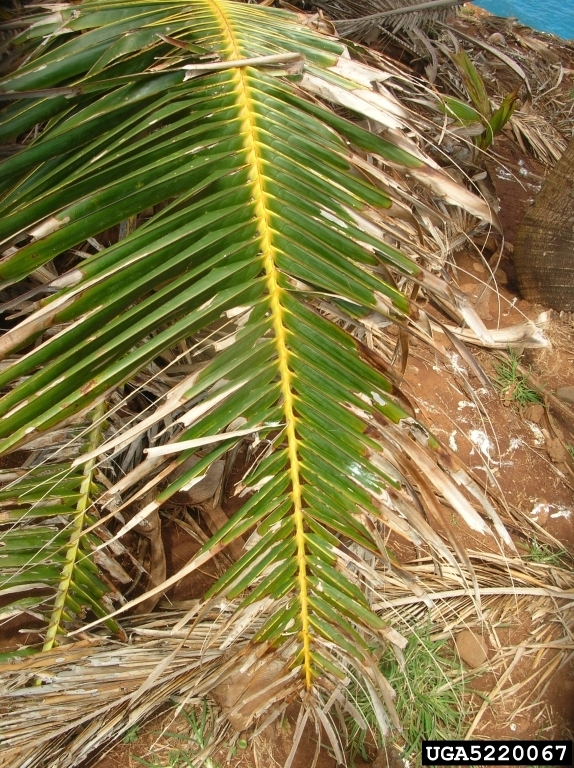
Damage due to coconut leafrollers

Coconut leafroller larvae

Coconut leafroller (Hedylepta blackburni) adult

Coconut leafroller (Hedylepta blackburni) larvae damage to coconut leaves.

Coconut leafroller pupae and frass

Coconut leafroller feeding on leaves

Coconut leafroller pupa, larva and frass.
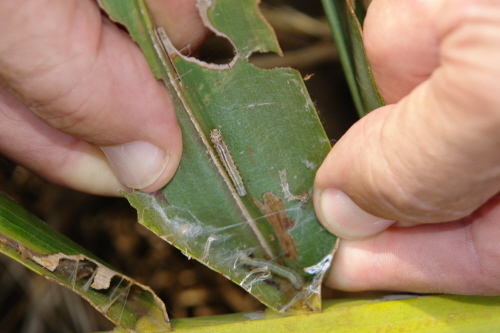
Coconut leafroller rolls leaf near midrib of frond
Symptoms
The larvae feeds on under surface of leaves. Usually they found protected by silken web. Initially they feed on the lower epidermis leaving the upper epidermis intact. The larvae often fold two sides of leaflets by a silken thread and feed inside. The later stage larvae feeds on both upper and lower epidermis of leaves. Severe infestation leads to skeletonization of fronds.
Cause
Insect
Comments
Management
Encourage natural enemies in the orchard.
Coconut rhinoceros beetle
Oryctes rhinoceros

Damaged coconut frond

coconut rhinoceros beetle (Oryctes rhinoceros) adult

Lure and trap for Coconut Rhinoceros Beetle
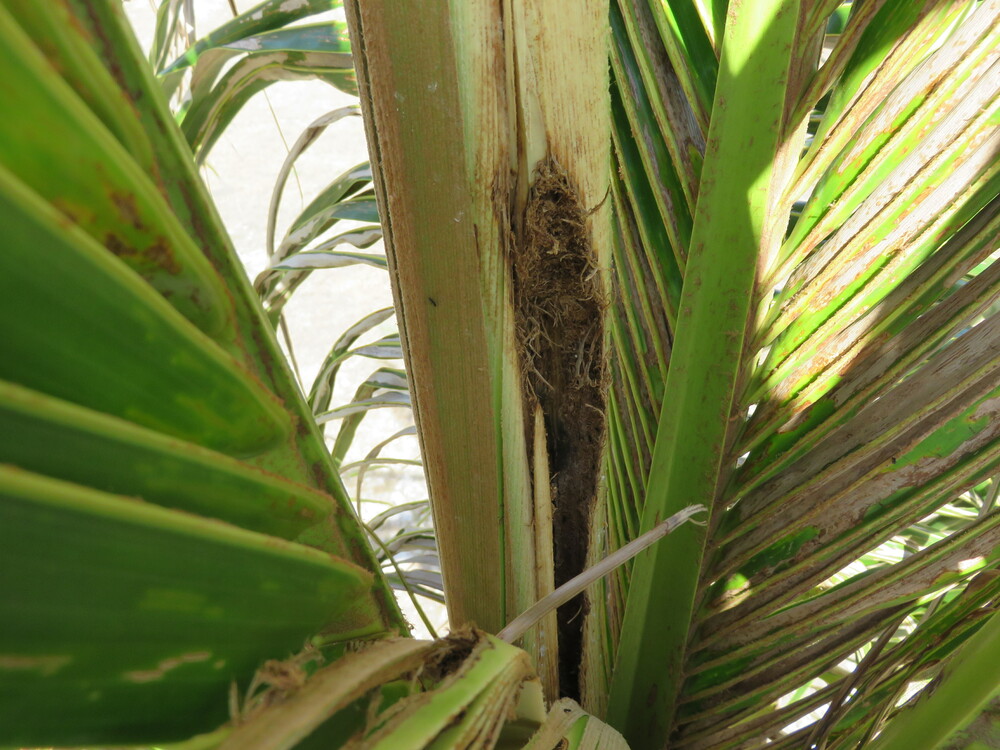
coconut rhinoceros beetle injury to young coconut tree

coconut rhinoceros beetle (Oryctes rhinoceros) pupae

Damage due to coconut rhinoceros beetle
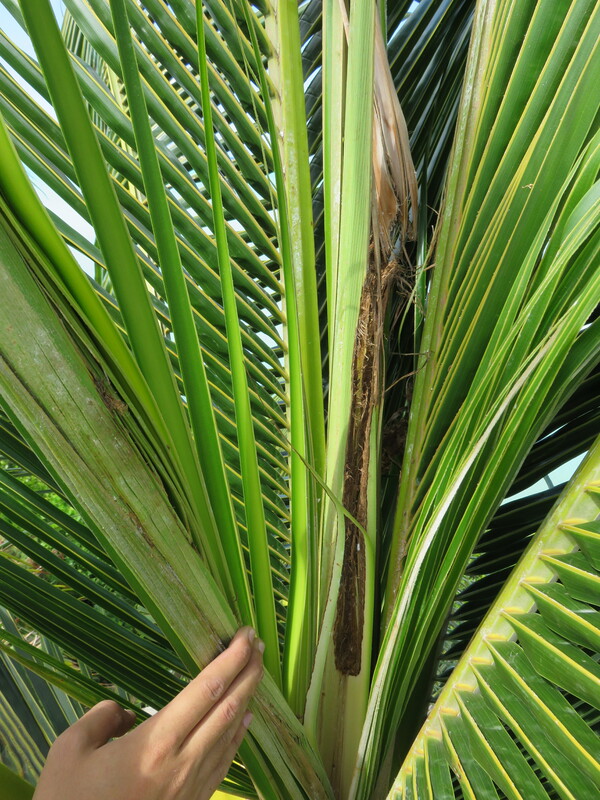
Rhinoceros beetle damage

Coconut rhinoceros beetle larvae

coconut rhinoceros beetle (Oryctes rhinoceros) injured trees
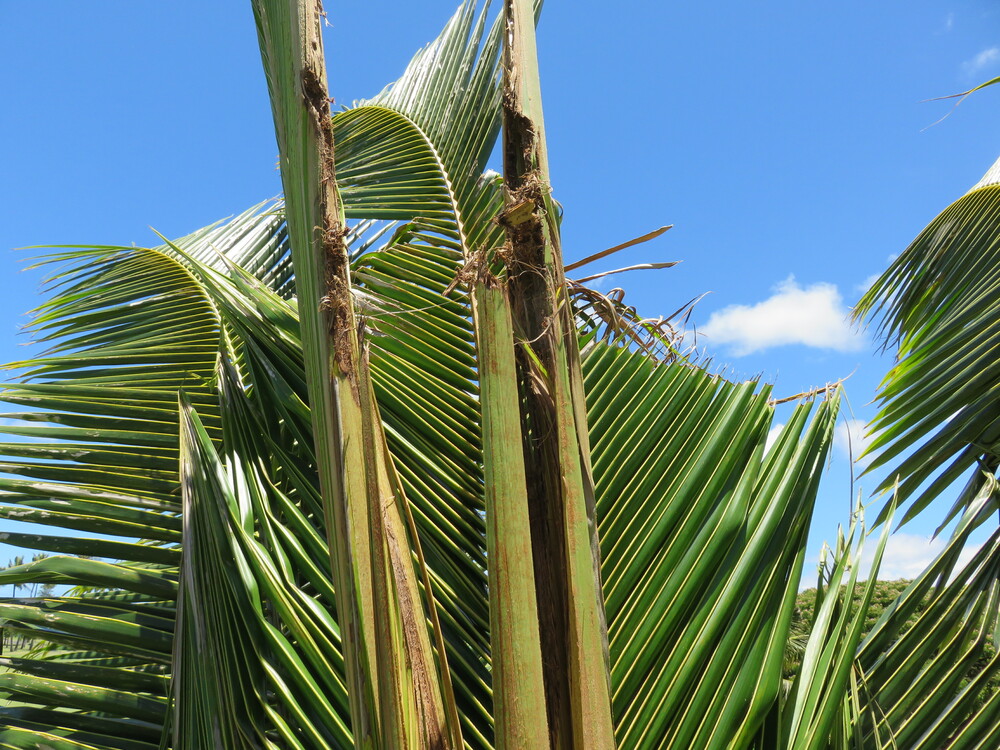
Damage due to rhinoceros beetle

Coconut Rhinoceros Beetle (CRB)

The Asiatic rhinoceros beetle or coconut rhinoceros beetle (Oryctes rhinoceros) damage to coconut
Symptoms
V-shaped cuts in palm fronds or holes in leaf midribs caused by beetles boring into crown to feed; adult insect is a large black beetle with a curved spine on its head; larvae are creamy white grubs with brown heads and 3 sets of prolegs at the anterior (head) end.
Cause
Insect
Comments
Management
Destroy any decaying logs in plantation by chopping and burning to kill any larvae that may be inside; remove any dead trees from plantation and destroy by burning; plant a cover crop to deter egg laying by females as they do not lay eggs in areas covered by vegetation; hooked wire can be used to extract larvae that are boring into young crowns.
Coconut scale
Aspidiotus destructor

coconut scale (Aspidiotus destructor) infestation

coconut scale (Aspidiotus destructor)

Scale on coconut foliage
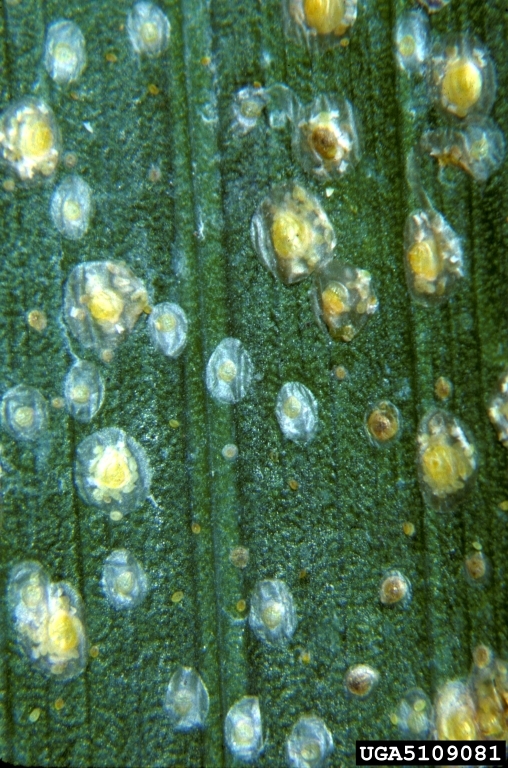
Coconut scale (Aspidiotus destructor) adults

Coconut scale infestation

Coconut scale damage

coconut scale (Aspidiotus destructor) adults and early instars

coconut scale (Pinnaspis buxi)

Coconut scale damage
Symptoms
Pale yellow spots on leaves; entire leaves yellowing; leaves turning brown and dropping prematurely; adult insect is a flattened oval, resembling a scale, which is red-brown in color.
Cause
Insect
Comments
Management
May be possible to control coconut scale by pruning infested parts of trees and destroying by burning; chemical control may be necessary.
Mealybugs (Pineapple mealybug, Striped mealybug, Cocoa mealybug, etc.)
Dysmicoccus brevipes
Ferrisia virgata
Planococcus lilacinus

Coconut (Cocos nucifera): Mealybugs and scales on leaflet
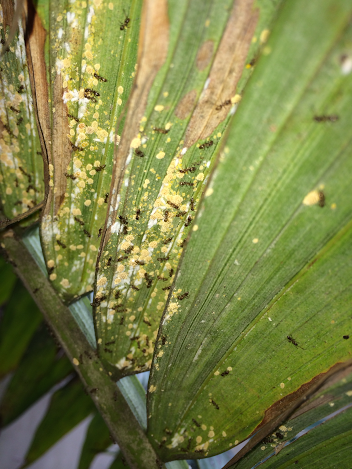
coconut mealybugs (Nipaecoccus nipae) tended by ants
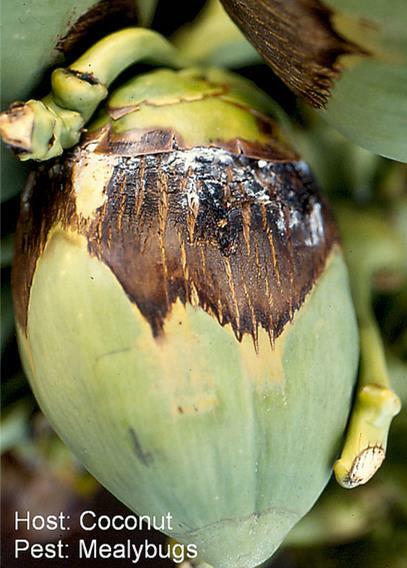
Coconut mealybug damage

Coconut mealybugs (Nipaecoccus nipae)

Coconut mealybug (Nipaecoccus nipae) adult

Colony of coconut mealybugs (Nipaecoccus nipae)
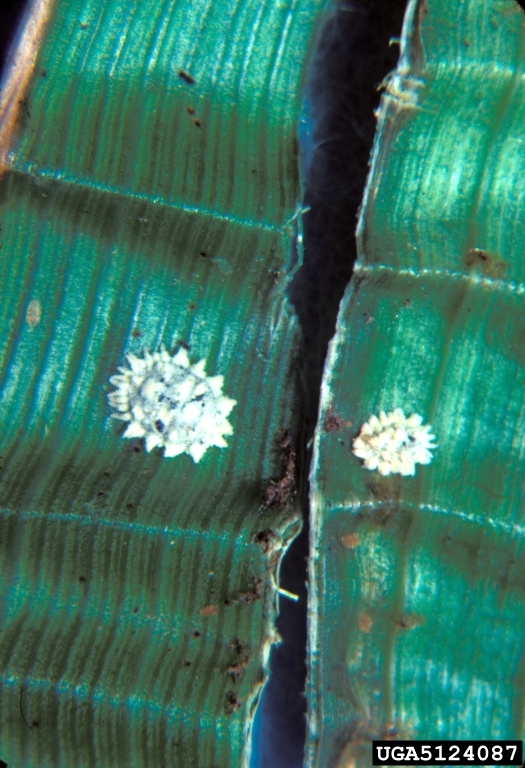
Adults of coconut mealybug (Nipaecoccus nipae)
Symptoms
Flattened oval to round disc-like insect covered in waxy substance on tree branches; insects attract ants which may also be present; insect colony may also be associated with growth of sooty mold due to fungal colonization of sugary honeydew excreted by the insect; symptoms of direct insect damage not well documented but trees may exhibit symptoms of cocoa swollen shoot (see disease entry).
Cause
Insect
Comments
Management
Mealybugs can potentially be controlled by natural enemies such as lady beetles but are commonly controlled using chemicals; chemical pesticides may also decrease populations of natural enemies leading to mealybug outbreaks.
Category : Mites
Eriophyid coconut mite
Aceria guerreronis
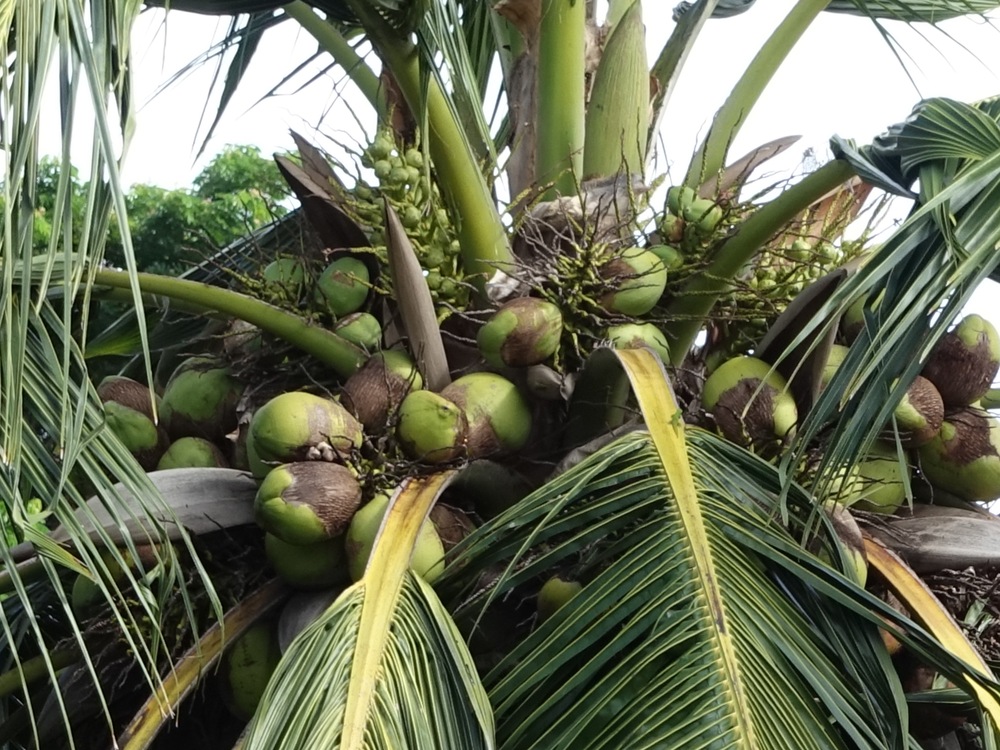
Coconut: Eriophyid mites injury to nuts

Coconut mite damage coconut fruits

Coconut mite feeding injury

Mite damage

Scarring of coconut fruits due to coconut mites

Eriophyid mites feeding injury to coconut

Mite feeding injury

Symptoms due to coconut mite infestation

Coconut mite damage on fruits of coconut
Symptoms
The mites suck sap from young nuts. Generally they feed on meristematic zone, i.e., the area which is covered by perianth. The infestation starts very early. As the nut develops the feeding leaves brown fissures that extending down from the perianth. The nut becomes small and distorted.
Cause
Mites
Comments
Management
Provide proper fertilizer and water for trees to withstand mite damage. Encourage natural enemies of mite in the orchard. If infestation is severe, apply suitable insecticide by root feeding or stem injection.
Category : Nematodes
Red ring nematode (Coconut palm nematode)
Bursaphelenchus cocophilus
Symptoms
Nuts falling prematurely; withering inflorescences; yellowing leaves which then turn brown; orange to red-brown ring of discoloration when a cross section is taken of lower stem.
Cause
Nematode
Comments
Management
If a tree becomes infected it should be removed and destroyed; control of the disease is currently limited to efforts to control the weevil which transmits the nematode to the palms.













































































